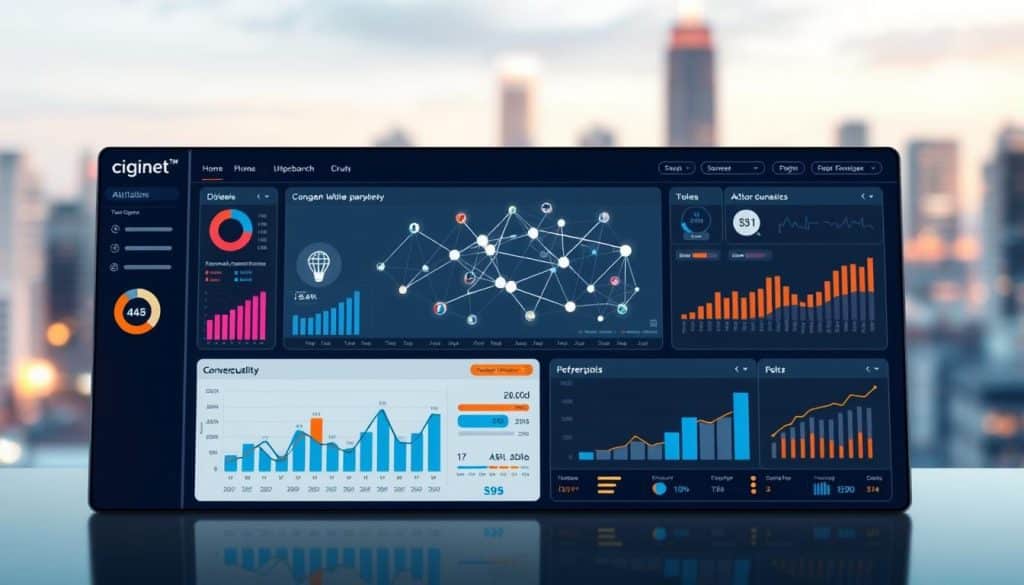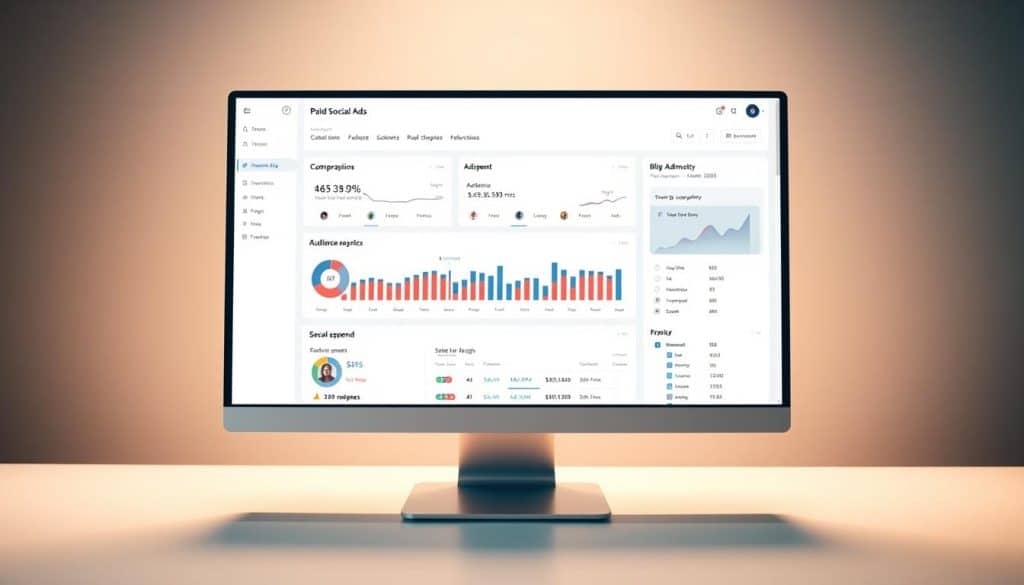Did you know that acquiring a new client costs between 5 to 25 times more than keeping an existing one? This fact shows why Canadian businesses are focusing more on keeping customers than getting new ones. Customer retention is about keeping loyalty strong over time and shows your place in the market.
Your success is more than just the first sale. To build lasting relationships, you need strategies that keep clients coming back. This guide offers practical tips to turn one-time buyers into brand advocates who choose your business again and again.
Whether you run a big company or a small one, this guide is for you. You’ll learn retention strategies that increase lifetime value and strengthen personal connections. These proven methods lead to real results, helping your business grow in tough markets.
Reputation Management (Powered by AI Arkitechs)
Turn Reviews into Revenue!
Automate and manage your online reputation with AI-powered tools. Build a 5-star brand effortlessly!
Key Takeaways
- Retaining existing clients costs 5-25 times less than acquiring new ones, making loyalty programs essential for profitability
- Effective retention tactics reduce churn while increasing lifetime value through consistent engagement
- Building strong relationships transforms buyers into brand advocates who promote your business organically
- Personalized experiences and proactive communication strengthen bonds with your client base
- Measuring retention metrics helps identify areas for improvement and tracks success over time
- Small businesses and enterprises alike benefit from implementing structured retention frameworks
Why Customer Retention Matters More Than Ever
Customer retention is now key to business success in every field. Companies are shifting their focus from just getting new customers to keeping the ones they have. This change is crucial for long-term growth.
The market has changed a lot. Customers have more choices and expect better experiences. Keeping customers happy is now more important than ever.
Studies show focusing on retention is a smart move. McKinsey’s 2024 Customer Experience and Loyalty Report found that personalized strategies lead to loyal customers. These companies are thriving in ways others can’t.
The Cost-Effectiveness of Retention Versus Acquisition
Acquiring a new customer costs 5 to 25 times more than keeping an existing one. This big difference affects your business model.
Getting new customers means spending on marketing and sales. You need to convince strangers to trust your brand. This costs a lot before they start making money for you.
Keeping customers is different. They already know your brand. Spending on them brings better returns because you’re building on a relationship.
- Acquisition costs: Include advertising, lead generation, sales cycles, onboarding, and initial discounts
- Retention costs: Focus on customer success, loyalty programs, personalized communications, and experience improvements
- ROI comparison: Retention investments typically deliver 3-7x better returns than equivalent acquisition spending
- Resource allocation: Smart businesses shift budget toward retention once they understand these economics
In Canada, word-of-mouth is very powerful. Every dollar you invest in retention doesn’t just keep one customer—it creates advocates who bring others to your business organically.
Impact on Customer Lifetime Value and Profitability
Customer lifetime value shows the profit a customer brings over time. This changes how you measure success and use resources.
Research by Harvard Business Review shows a 5% increase in retention can boost profits by 25% to 95%. A small improvement in keeping customers can lead to big profit growth.
Loyal customers become more valuable over time. They buy more, upgrade, and need less support. They’re willing to pay more because they trust you.
Our clients see this pattern. A customer who stays for three years can generate 3-5 times more profit than one who leaves after a single transaction. This creates a strong competitive advantage.
| Retention Rate | Average Customer Lifespan | Lifetime Value Multiplier | Profit Impact |
|---|---|---|---|
| 70% | 1.5 years | 1.0x baseline | Baseline |
| 75% | 2.0 years | 1.8x baseline | +28% profit |
| 80% | 2.5 years | 2.5x baseline | +52% profit |
| 85% | 3.3 years | 3.6x baseline | +89% profit |
Declining retention often means deeper issues. It signals a drop in experience quality that needs attention. We see retention metrics as a warning for business health.
Building Sustainable Revenue Growth
Retention strategies create stable, recurring revenue. This stability changes how you plan and grow your business.
Acquisition-focused businesses face unpredictable revenue. Market changes, advertising costs, and competitor actions disrupt plans. You’re always filling the top of your funnel just to keep revenue steady.
Retention-based growth is different. Each quarter builds on the last. Your customer base grows in value, providing increasing returns. You start with loyal customers and add new ones on top.
This approach makes you less vulnerable to market changes. In uncertain times, businesses with strong retention stay stable while others struggle. Canadian businesses benefit from this stability due to seasonal market changes and global economic ties.
The effect of retention is amazing. Combining high retention with steady new customers leads to natural growth. Happy customers become advocates, reducing acquisition costs and increasing conversion rates. This creates a cycle where retention fuels growth through word-of-mouth and reputation.
We teach our clients to see retention as the most powerful growth engine. The winners in today’s market aren’t those with the biggest budgets for new customers. They’re the ones who keep customers coming back.
Understanding Key Customer Retention Metrics
Measuring what matters turns your customer retention efforts into a winning strategy. Canadian businesses often struggle to find the right metrics. But, tracking the right retention metrics gives you the clarity to make informed decisions that drive growth.
Without proper measurement, you’re flying blind through your customer relationships. The metrics we’ll explore in this section provide the data foundation for your retention strategy. Each number tells a story about customer behavior, satisfaction, and the health of your business relationships.
How to Calculate Customer Retention Rate
Your customer retention rate shows how well you keep your existing customers. We use a simple formula: (Number of customers at end of period – New customers acquired) / Customers at start of period × 100.
Let’s use an example. Suppose you started with 200 customers, got 40 new ones, and ended with 220. Your calculation would be: (220 – 40) / 200 × 100 = 90% retention rate.
This metric gives you a clear view of customer loyalty over time. We recommend tracking this monthly, quarterly, and annually. A healthy retention rate varies by industry, but most successful businesses keep rates above 85%.
Tracking and Reducing Churn Rate
While retention rate shows who stays, churn rate reveals who leaves. Understanding both is key for churn reduction strategies. Calculate your churn rate using this formula: (Number of customers lost / Number of customers at start) × 100.
For example, if you started with 1,000 customers and lost 50, your churn rate is 5%. This number is your baseline for improvement.
We help businesses monitor churn to identify trends before they become big problems. Look for patterns in when customers leave. These insights guide your churn reduction initiatives and help you allocate resources effectively.
| Metric Type | What It Measures | Ideal Benchmark | Monitoring Frequency |
|---|---|---|---|
| Customer Retention Rate | Percentage of customers who continue purchasing | 85% or higher | Monthly/Quarterly |
| Churn Rate | Percentage of customers who stop purchasing | Below 5% monthly | Weekly/Monthly |
| Net Promoter Score | Customer loyalty and advocacy likelihood | Above 50 | Quarterly |
| Customer Lifetime Value | Total revenue expected from customer relationship | 3x acquisition cost | Quarterly/Annually |
Measuring Net Promoter Score for Loyalty Insights
Net Promoter Score offers a direct window into customer sentiment. It asks one powerful question: “How likely are you to recommend our business to a friend or colleague on a scale of 0-10?”
The responses fall into three distinct categories that tell you everything about customer satisfaction:
- Promoters (9-10): Enthusiastic advocates who fuel your growth through referrals and repeat purchases
- Passives (7-8): Satisfied customers who remain vulnerable to competitive offerings
- Detractors (0-6): Unhappy customers who may damage your reputation through negative word-of-mouth
We use this data to gauge overall satisfaction and pinpoint specific areas for improvement. Calculate your NPS by subtracting the percentage of Detractors from the percentage of Promoters. A score above 50 is excellent, while anything above 70 is world-class.
Analyzing Customer Lifetime Value
Understanding customer lifetime value helps you make smart investment decisions. This metric represents the total revenue you can expect from a customer throughout your entire relationship.
The formula combines three essential components: Average purchase value × Purchase frequency × Customer lifespan. Let’s apply this with real numbers. If your average purchase is $50, customers buy four times per year, and they typically stay for three years, your CLV equals $600.
This calculation transforms how you view customer relationships. Instead of seeing a $50 transaction, you recognize a $600 opportunity. We use customer lifetime value analysis to determine which customer segments deserve the most attention and resources.
Beyond these core metrics, we also track Net Revenue Retention (NRR), which measures revenue growth from existing customers through upsells and cross-sells. Monitoring adoption rates, usage patterns, and consumption metrics provides additional layers of insight into customer engagement and potential churn risks.
The key is establishing a measurement cadence that works for your business. We recommend starting with these fundamental retention metrics and expanding your tracking as you develop more sophisticated retention strategies. Remember: what gets measured gets managed, and consistent tracking is the first step toward meaningful improvement in customer retention.
Creating an Exceptional Customer Experience
Creating memorable experiences is key to keeping customers. Customer experience includes every interaction, from the first visit to ongoing support. It requires careful planning and a genuine commitment to client satisfaction.
Forrester’s research shows that focusing on customers leads to better growth and retention. These companies know that experiences shape perceptions more than ads do.
Mapping and Optimizing the Customer Journey
Understanding the customer journey is crucial for retention planning. We help clients document every touchpoint and emotional response. This shapes the journey from awareness to long-term partnership.
To create a detailed customer journey map, gather data from various sources. Start by interviewing customers and analyzing support tickets. Also, review website analytics and consult with frontline team members. This reveals where customer experience excels and where it falters.
First impressions are vital in retention planning. A poor onboarding experience can harm your brand and lead to customer loss. On the other hand, a well-designed onboarding process sets the stage for lasting relationships.
Your onboarding workflow should include essential elements:
- Clear internal task assignments with accountability tracking
- Strategically timed email sequences that guide without overwhelming
- Proactive follow-up messaging to address questions before they become problems
- Self-service knowledge base access for independent problem-solving
- Celebratory messaging acknowledging milestones and progress
We focus on critical moments that impact retention. These include the first purchase, initial product usage, first support interaction, and renewal decision points. Optimizing these touchpoints maximizes your customer experience investments.
| Journey Stage | Key Touchpoints | Optimization Focus | Impact on Retention |
|---|---|---|---|
| Onboarding | Welcome emails, setup guides, first interactions | Clarity, accessibility, quick wins | Establishes foundation for long-term relationship |
| Active Usage | Product features, support channels, educational content | Value demonstration, problem resolution | Builds confidence and dependency |
| Renewal Decision | Usage reviews, outcome discussions, pricing conversations | ROI evidence, relationship strength | Directly determines continuation |
| Advocacy | Referral requests, testimonials, case studies | Recognition, reciprocity, community | Transforms customers into growth partners |
Ensuring Consistency Across All Touchpoints
Customers interact with your business through various channels. Client satisfaction depends on delivering consistent experiences across all channels.
Inconsistency can confuse and erode trust. If your website promises one thing but your support team delivers another, customers question your reliability. We help businesses align messaging and maintain service quality standards.
Consider this scenario: A customer researches your services online, then calls your sales team with specific questions. Later, they email support about implementation details. If each interaction feels disconnected, the customer experience suffers.
Customers don’t think in channels. They expect a seamless experience across all touchpoints, and companies that fail to deliver consistency will lose to competitors who do.
Technology is key in maintaining consistency. Customer relationship management systems should provide complete interaction histories. When a support agent can reference previous conversations, customers feel valued and understood.
Your brand promise should remain constant across every touchpoint. The tone, values, and commitments you communicate through marketing must align with what customers experience. This consistency shows professionalism and respect for your customers’ time and trust.
We recommend conducting regular audits of all customer touchpoints. Review communications from different departments and experience your purchase process as a customer would. Also, solicit feedback about consistency from recent clients. These audits reveal disconnects that might be invisible to internal teams.
Delivering Beyond Expected Service Standards
Meeting customer expectations creates satisfaction, but exceeding expectations turns satisfied customers into brand advocates. We encourage businesses to build reliability first, then look for opportunities to deliver unexpected delight.
Reliability is the non-negotiable baseline for client satisfaction. Customers expect you to deliver what you promise and respond promptly. Without this foundation, attempts to exceed expectations feel hollow.
Once you’ve established consistent reliability, consider these strategies for exceeding service standards:
- Proactive outreach: Contact customers before problems arise, offering preventive solutions or helpful resources based on usage patterns
- Personalized recommendations: Analyze customer behavior to suggest relevant products, features, or strategies tailored to their specific goals
- Surprise recognition: Acknowledge customer anniversaries, milestones, or achievements with unexpected gestures of appreciation
- Empowered flexibility: Give your team authority to make judgment calls that prioritize long-term relationships over short-term profits
- Educational value: Share insights, industry trends, and best practices that help customers succeed beyond your specific products or services
Small gestures carry big impact when they show genuine care and attention. A handwritten thank-you note, a proactive phone call, or expedited shipping at no additional cost creates memorable experiences. These experiences are shared with colleagues and friends.
This organic word-of-mouth marketing generates value that paid advertising cannot replicate. When customers enthusiastically recommend your business based on exceptional experiences, they bring you qualified prospects who already trust your capabilities.
We emphasize that exceeding expectations doesn’t require expensive gestures or unsustainable promises. Often, the most powerful moments come from simply paying attention, anticipating needs, and showing customers they matter beyond their transaction value. These human touches create emotional connections that strengthen retention more effectively than any discount or promotion.
Personalization Strategies That Drive Customer Loyalty
In today’s market, treating each customer as an individual is key. Gone are the days of generic messages. Customers now expect brands to remember their preferences and needs.
This shift boosts customer loyalty and keeps customers coming back. To build long-term relationships, go beyond basic customization. Create meaningful interactions at every touchpoint.
Econsultancy’s research shows 80% of companies see a boost in customer loyalty with personalization. This proves personalization is more than a trend. It’s a strategy that works for businesses willing to understand their customers.
Leveraging Customer Data for Meaningful Insights
Start by collecting the right info at every interaction. We help businesses track behaviors, preferences, and more. The goal is to turn customer data into useful insights.
Analytics tools uncover patterns and trends. They show what customers value most. This helps your business be proactive, not just reactive.
Respect privacy while gathering important data. Track website behavior, purchase history, and more. Each piece of data helps paint a complete picture of each customer.
The power of customer data is in anticipating needs. Use historical data to predict future behavior. Identify products that complement previous purchases and solve emerging challenges.
Customizing Communications and Product Recommendations
Move beyond generic emails to strengthen customer loyalty. Create personalized messages that speak to specific needs and interests. Reference previous purchases and make recommendations based on actual behavior.
Dynamic website content and email campaigns that respond to actions create a better experience. Product suggestions based on purchase history and browsing patterns show you’re paying attention.
Personalized communications should reflect each customer’s journey. New customers need guidance, while established ones appreciate advanced tips. Each message should feel tailored to the recipient.
We help clients develop recommendation engines that suggest products based on various factors. Consider purchase history, browsing behavior, and more. These recommendations should add value and enhance the customer experience.
Advanced Segmentation for Targeted Engagement
Take personalization further by dividing your customer base into distinct groups. We create segments based on industry, company size, and more. This approach helps deliver more relevant experiences that strengthen long-term relationships.
Each segment gets tailored messaging and offers. High-value customers get dedicated account management. Newer customers get enhanced onboarding support. The goal is to make each segment feel understood and valued.
Advanced segmentation goes beyond basic demographics. We identify segments based on engagement frequency and more. These segments reveal opportunities for targeted experiences that drive retention and satisfaction.
Consider segments for at-risk customers, power users, and growth-potential accounts. Each segment needs different strategies and resources to maximize results and build loyalty.
Building Strong Communication Channels
We think open communication is key to strong customer ties. Businesses that invest in good communication show they care about their customers’ success. These channels help your team quickly solve problems and build trust, leading to repeat business.
The quality of your communication affects how customers see your brand. Every interaction shapes their customer experience. It decides if they stay loyal or look elsewhere.
Establishing Multi-Channel Support Systems
We help businesses set up support systems where customers can choose how to contact them. Whether it’s email, phone, live chat, social media, or a knowledge base, your team should provide quality service on every platform.
The secret to great multi-channel support is seamless integration. Your team needs to know everything about a customer, no matter how they contact you. If a customer chats and then calls, your team should have all the details.
Offering support across all channels makes customers happy. They want to be heard and helped fast. Your team should be ready to assist at any time, day or night.
| Communication Channel | Best Use Case | Response Time Expectation | Customer Preference Rate |
|---|---|---|---|
| Live Chat | Quick questions and immediate problem-solving | Under 2 minutes | 42% prefer for urgent issues |
| Email Support | Detailed inquiries and documentation needs | Within 24 hours | 68% prefer for complex questions |
| Phone Support | Complex issues requiring detailed explanation | Immediate to 5 minutes | 53% prefer for serious concerns |
| Social Media | Public engagement and quick updates | Within 1 hour | 37% prefer for brand interaction |
| Self-Service Portal | Common questions and after-hours support | Instant access | 81% try this first |
Training your support teams to show empathy is crucial. They should listen well and address concerns with care. This makes your customer experience memorable and builds loyalty.
Implementing Proactive Outreach and Follow-Up
Even if customers don’t reach out, your teams should still communicate. We suggest using a communication calendar for regular touchpoints. This makes your communication more focused on building relationships.
A good communication calendar helps manage customer interactions well. It lets you understand their feelings, challenges, and opportunities for growth. This approach is key to building strong customer relationships.
Consider adding these proactive touchpoints:
- Onboarding check-ins in the first 30 days to ensure smooth adoption
- Quarterly business reviews to assess progress and find growth chances
- Product update notifications that highlight new features
- Renewal reminders sent early with added value
- Satisfaction surveys at key times to get feedback
Showing you value the relationship beyond just sales is important. When customers need help, follow up after solving their issue. This shows you’re committed to making things right and care about their success, which boosts repeat business.
Maintaining Transparency and Authenticity
We encourage businesses to be honest about what they can and can’t do. Being transparent builds trust and strengthens relationships, even through tough times.
If mistakes happen, own up to them fast and apologize sincerely. Explain how you’ll prevent it from happening again and fix it right away.
96% of customers will keep buying from a company that apologizes and fixes mistakes properly.
HubSpot Research
This shows that customers value honesty more than being perfect. They know mistakes happen, but they expect honest communication and effort to fix them.
Share behind-the-scenes looks at your team and explain your decisions. Use real people to talk instead of corporate jargon. This makes your brand stand out and creates emotional connections.
Canadian businesses that are open in their communication keep customers longer. Customers like clear talks about prices, what you can do, and when. This honesty avoids misunderstandings and sets the right expectations, leading to repeat business.
Conclusion
Keeping customers is key for businesses wanting to grow. It’s cheaper to keep customers than to get new ones. Happy customers also spend more over time.
We’ve talked about ways to keep customers happy. Personalized experiences and loyalty programs are just a few. Each method helps build stronger bonds with your customers. The right mix can make a big difference for your business.
First, check how well you’re keeping customers. Find out who’s staying and who’s leaving. This helps you know where to focus your efforts.
Real commitment is needed to keep customers coming back. Show them you care, and they’ll be loyal. Happy customers help bring in new ones, saving you money.
Start with one or two strategies to see results. It could be better onboarding, a loyalty program, or new tech. The important thing is to begin now. Keeping customers is an ongoing effort that pays off in the long run.
FAQ
What is customer retention and why is it important for business growth?
Customer retention means keeping your current customers happy and coming back. It’s key because keeping customers costs less than getting new ones. A 5% better retention rate can boost profits by 25% to 95%, Harvard Business Review says.
FAQ
What is customer retention and why is it important for business growth?
Customer retention means keeping your current customers happy and coming back. It’s key because keeping customers costs less than getting new ones. A 5% better retention rate can boost profits by 25% to 95%, Harvard Business Review says.
How do I calculate my customer retention rate?
FAQ
What is customer retention and why is it important for business growth?
Customer retention means keeping your current customers happy and coming back. It’s key because keeping customers costs less than getting new ones. A 5% better retention rate can boost profits by 25% to 95%, Harvard Business Review says.
FAQ
What is customer retention and why is it important for business growth?
Customer retention means keeping your current customers happy and coming back. It’s key because keeping customers costs less than getting new ones. A 5% better retention rate can boost profits by 25% to 95%, Harvard Business Review says.
What's the difference between churn rate and retention rate?
FAQ
What is customer retention and why is it important for business growth?
Customer retention means keeping your current customers happy and coming back. It’s key because keeping customers costs less than getting new ones. A 5% better retention rate can boost profits by 25% to 95%, Harvard Business Review says.
FAQ
What is customer retention and why is it important for business growth?
Customer retention means keeping your current customers happy and coming back. It’s key because keeping customers costs less than getting new ones. A 5% better retention rate can boost profits by 25% to 95%, Harvard Business Review says.
What is Net Promoter Score and how does it help with retention?
FAQ
What is customer retention and why is it important for business growth?
Customer retention means keeping your current customers happy and coming back. It’s key because keeping customers costs less than getting new ones. A 5% better retention rate can boost profits by 25% to 95%, Harvard Business Review says.
FAQ
What is customer retention and why is it important for business growth?
Customer retention means keeping your current customers happy and coming back. It’s key because keeping customers costs less than getting new ones. A 5% better retention rate can boost profits by 25% to 95%, Harvard Business Review says.
How much should I invest in customer retention versus acquisition?
FAQ
What is customer retention and why is it important for business growth?
Customer retention means keeping your current customers happy and coming back. It’s key because keeping customers costs less than getting new ones. A 5% better retention rate can boost profits by 25% to 95%, Harvard Business Review says.
FAQ
What is customer retention and why is it important for business growth?
Customer retention means keeping your current customers happy and coming back. It’s key because keeping customers costs less than getting new ones. A 5% better retention rate can boost profits by 25% to 95%, Harvard Business Review says.
What are the most effective customer retention strategies for small businesses?
FAQ
What is customer retention and why is it important for business growth?
Customer retention means keeping your current customers happy and coming back. It’s key because keeping customers costs less than getting new ones. A 5% better retention rate can boost profits by 25% to 95%, Harvard Business Review says.
FAQ
What is customer retention and why is it important for business growth?
Customer retention means keeping your current customers happy and coming back. It’s key because keeping customers costs less than getting new ones. A 5% better retention rate can boost profits by 25% to 95%, Harvard Business Review says.
How do I reduce customer churn in my business?
FAQ
What is customer retention and why is it important for business growth?
Customer retention means keeping your current customers happy and coming back. It’s key because keeping customers costs less than getting new ones. A 5% better retention rate can boost profits by 25% to 95%, Harvard Business Review says.
FAQ
What is customer retention and why is it important for business growth?
Customer retention means keeping your current customers happy and coming back. It’s key because keeping customers costs less than getting new ones. A 5% better retention rate can boost profits by 25% to 95%, Harvard Business Review says.
What is personalization and how does it impact retention?
FAQ
What is customer retention and why is it important for business growth?
Customer retention means keeping your current customers happy and coming back. It’s key because keeping customers costs less than getting new ones. A 5% better retention rate can boost profits by 25% to 95%, Harvard Business Review says.
FAQ
What is customer retention and why is it important for business growth?
Customer retention means keeping your current customers happy and coming back. It’s key because keeping customers costs less than getting new ones. A 5% better retention rate can boost profits by 25% to 95%, Harvard Business Review says.
How do loyalty programs improve customer retention?
FAQ
What is customer retention and why is it important for business growth?
Customer retention means keeping your current customers happy and coming back. It’s key because keeping customers costs less than getting new ones. A 5% better retention rate can boost profits by 25% to 95%, Harvard Business Review says.
FAQ
What is customer retention and why is it important for business growth?
Customer retention means keeping your current customers happy and coming back. It’s key because keeping customers costs less than getting new ones. A 5% better retention rate can boost profits by 25% to 95%, Harvard Business Review says.
What is Customer Lifetime Value and how do I calculate it?
FAQ
What is customer retention and why is it important for business growth?
Customer retention means keeping your current customers happy and coming back. It’s key because keeping customers costs less than getting new ones. A 5% better retention rate can boost profits by 25% to 95%, Harvard Business Review says.
FAQ
What is customer retention and why is it important for business growth?
Customer retention means keeping your current customers happy and coming back. It’s key because keeping customers costs less than getting new ones. A 5% better retention rate can boost profits by 25% to 95%, Harvard Business Review says.
How can I create a customer-centric company culture?
FAQ
What is customer retention and why is it important for business growth?
Customer retention means keeping your current customers happy and coming back. It’s key because keeping customers costs less than getting new ones. A 5% better retention rate can boost profits by 25% to 95%, Harvard Business Review says.
FAQ
What is customer retention and why is it important for business growth?
Customer retention means keeping your current customers happy and coming back. It’s key because keeping customers costs less than getting new ones. A 5% better retention rate can boost profits by 25% to 95%, Harvard Business Review says.
What are the early warning signs that a customer is about to churn?
FAQ
What is customer retention and why is it important for business growth?
Customer retention means keeping your current customers happy and coming back. It’s key because keeping customers costs less than getting new ones. A 5% better retention rate can boost profits by 25% to 95%, Harvard Business Review says.
FAQ
What is customer retention and why is it important for business growth?
Customer retention means keeping your current customers happy and coming back. It’s key because keeping customers costs less than getting new ones. A 5% better retention rate can boost profits by 25% to 95%, Harvard Business Review says.
How do I win back customers who have already churned?
FAQ
What is customer retention and why is it important for business growth?
Customer retention means keeping your current customers happy and coming back. It’s key because keeping customers costs less than getting new ones. A 5% better retention rate can boost profits by 25% to 95%, Harvard Business Review says.
FAQ
What is customer retention and why is it important for business growth?
Customer retention means keeping your current customers happy and coming back. It’s key because keeping customers costs less than getting new ones. A 5% better retention rate can boost profits by 25% to 95%, Harvard Business Review says.
What technology tools are essential for customer retention?
FAQ
What is customer retention and why is it important for business growth?
Customer retention means keeping your current customers happy and coming back. It’s key because keeping customers costs less than getting new ones. A 5% better retention rate can boost profits by 25% to 95%, Harvard Business Review says.
FAQ
What is customer retention and why is it important for business growth?
Customer retention means keeping your current customers happy and coming back. It’s key because keeping customers costs less than getting new ones. A 5% better retention rate can boost profits by 25% to 95%, Harvard Business Review says.
How important is customer feedback to retention efforts?
FAQ
What is customer retention and why is it important for business growth?
Customer retention means keeping your current customers happy and coming back. It’s key because keeping customers costs less than getting new ones. A 5% better retention rate can boost profits by 25% to 95%, Harvard Business Review says.
FAQ
What is customer retention and why is it important for business growth?
Customer retention means keeping your current customers happy and coming back. It’s key because keeping customers costs less than getting new ones. A 5% better retention rate can boost profits by 25% to 95%, Harvard Business Review says.
How can small teams deliver excellent customer retention without large resources?
FAQ
What is customer retention and why is it important for business growth?
Customer retention means keeping your current customers happy and coming back. It’s key because keeping customers costs less than getting new ones. A 5% better retention rate can boost profits by 25% to 95%, Harvard Business Review says.
FAQ
What is customer retention and why is it important for business growth?
Customer retention means keeping your current customers happy and coming back. It’s key because keeping customers costs less than getting new ones. A 5% better retention rate can boost profits by 25% to 95%, Harvard Business Review says.
What are the biggest mistakes businesses make with customer retention?
FAQ
What is customer retention and why is it important for business growth?
Customer retention means keeping your current customers happy and coming back. It’s key because keeping customers costs less than getting new ones. A 5% better retention rate can boost profits by 25% to 95%, Harvard Business Review says.
FAQ
What is customer retention and why is it important for business growth?
Customer retention means keeping your current customers happy and coming back. It’s key because keeping customers costs less than getting new ones. A 5% better retention rate can boost profits by 25% to 95%, Harvard Business Review says.






